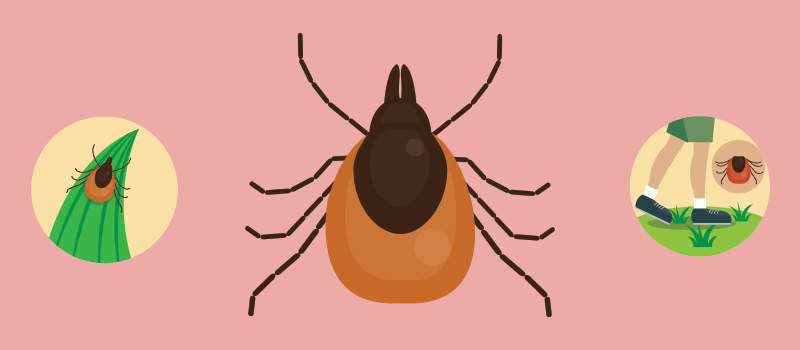What’s the Buzz
The Bee Healthy Blog
How to Prevent and Treat Tick Bites

According to the CDC, cases of tick-related illnesses such as Lyme disease, Rocky Mountain spotted fever, and a variety of other infections have more than doubled in the past 13 years with the highest reported number of ticks being reported in May. If you are bitten by a tick, the most important step to take is to remove the tick as soon as possible to avoid the risk of developing these diseases. In light of Lyme Disease Month—one of the most dangerous conditions spread by ticks—here’s everything you should know about prevention and treatment.
Types of Ticks
Different species of ticks carry different diseases. If possible, it’s important to identify which type of tick you have encountered to know how to treat the bite and if you should contact your healthcare provider. Ticks that transmit diseases include:
Blacklegged (Deer) tick: This dangerous tick transmits two bacteria that cause Lyme disease—Borrelia burgdorferi and B. mayonii—as well as other infections that can cause symptoms like fever, chills, headaches, and muscle aches. They are easily identified by their dark black legs, red-orange body, and black scutum (present on the upper portion of its shield)[3].
Lone star tick: Aggressive tick that can transmit diseases such as ehrlichiosis, tularemia, heartland virus disease, and bourbon virus disease[3].
American dog tick: Can transmit tularemia and Rocky Mountain spotted fever. The greatest risk of being bitten occurs during spring and summer[3].
Brown dog tick: Can cause Rocky Mountain spotted fever—Dogs are the primary host for the brown dog tick in each of its life stages, but this tick may also bite humans or other mammals.
Gulf coast tick: Transmits parkeri rickettsiosis, a form of spotted fever—adult ticks have been associated with transmitting this disease to humans.
Rocky mountain wood tick: Transmits Rocky Mountain spotted fever, Colorado tick fever virus, and tularemia.
Western blacklegged tick: Carries the bacteria that leads to Lyme disease, anaplasmosis, and Borrelia miyamotoi disease, a form of relapsing fever.
Soft ticks: They latch on (and painlessly feed) for less than 30 minutes, and can cause tick-borne relapsing fever (TBRF)[3].
Tick Removal
If you happen to get a tick, early removal is key in avoiding tick-borne illnesses. To safely remove an attached tick, follow these steps recommended by the CDC:
- Use sterilized fine-tipped tweezers to grasp the tick as close to the skin’s surface as possible.
- Pull upward with steady, even pressure. Don’t twist or jerk the tick, this can cause the mouth-parts to break off and remain in the skin. If this happens, remove the mouth-parts with tweezers. If you are unable to remove the mouth easily with tweezers, leave it alone and let the skin heal.
- After removing the tick, thoroughly clean the bite site and your hands with rubbing alcohol or soap and water.
- Never crush a tick with your fingers. Dispose of a live tick by putting it in alcohol, placing it in a sealed bag/container, wrapping it tightly in tape, or flushing it down the toilet.
Symptoms of Tick-borne Diseases
Many tick-borne diseases can have similar signs and symptoms—most will begin to occur within a few days to a few weeks after a tick bite. If you have been bit by a tick and develop the following symptoms, you should seek medical advice from your healthcare provider.
- Red spot or rash near the bite site
- Full body rash
- Neck stiffness
- Headache
- Nausea
- Weakness
- Muscle or joint pain or achiness
- Fever and chills
- Swollen lymph nodes
Lyme Disease
The CDC estimates there are more than 300,000 cases of Lyme infection in the U.S. each year[1]. In most cases, to transmit Lyme disease, a deer tick must be attached for 36 to 48 hours[4]. In the early stages, Lyme infection can be treated with antibiotics such as doxycycline for 10 days to 3 weeks, or amoxicillin and cefuroxime for 2 to 3 weeks.
Lyme disease can cause complications such as[4]:
- Chronic joint inflammation (Lyme arthritis), particularly of the knee
- Neurological symptoms, such as facial palsy and neuropathy
- Cognitive defects, such as impaired memory
- Heart rhythm irregularities
- Fever, chills, headache, fatigue, muscle and joint aches, and swollen lymph nodes may occur in the absence of rash
How to Avoid Tick Bites?
If you’re stepping foot into known tick territory be sure to follow these prevention tips:
- Wear protective clothing such as long sleeves, pants, hat, and socks—light-colored clothing is best to help you notice ticks.
- Use a chemical repellent with DEET, permethrin, or picaridin.
- Check yourself or have a family member help check you for ticks.
- Use a fine-tooth comb through your hair and check the folds of the skin.
[1] https://www.cdc.gov/ticks/removing_a_tick.html
[2] https://www.prevention.com/health/g27419738/types-of-ticks/
[3] https://www.cdc.gov/ticks/tickbornediseases/tickID.html
[4] https://www.mayoclinic.org/diseases-conditions/lyme-disease/symptoms-causes/syc-20374651


SOCIAL